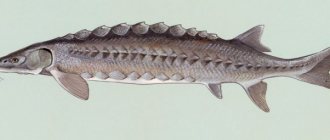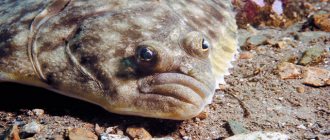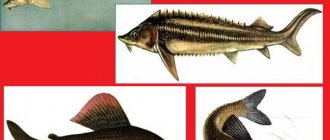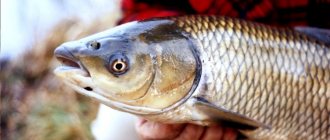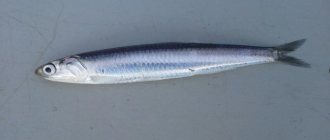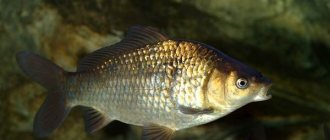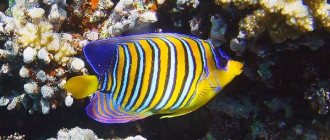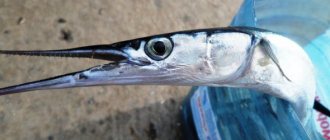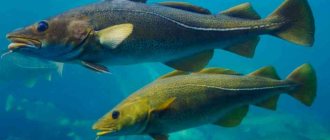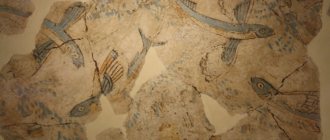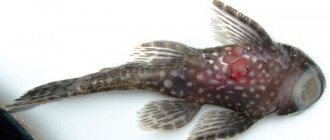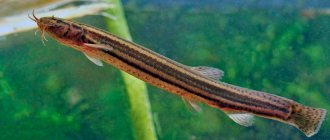Chub is a widespread medium-sized fish from the carp family. A characteristic feature of the chub is its large head, flattened on top, with a wide and flat forehead, for which it got its name. The chub is one of the popular fish among anglers who fish with fly, spinning, or float rods. There are conflicting opinions about the taste of chub meat. Some fishermen talk about the chub as a mediocre fish in terms of taste, which is interesting to catch, but not interesting to eat. Other fishermen, on the contrary, praise the chub for the taste of its meat. Let's tell you more about this fish.
Appearance
In appearance, the chub is an incredibly beautiful fish. The chub has a strong, elongated cylindrical body, slightly compressed from the sides and gradually tapering towards the tail. The shape of the chub’s body immediately shows that it is an excellent swimmer and is able to successfully withstand strong currents.
The head of the chub is much larger than the heads of most other fish found in our reservoirs. The chub's head is slightly flattened on top and has a wide and flat forehead. The chub got its name from its forehead-shaped head: chub, golovel and smut.
The chub has large, shiny, yellowish eyes. There is a brownish-yellow spot at the top of the eye.
The chub has a large semi-upper mouth, with a wide slit, the lower jaw protrudes slightly forward. The lips are thick, fleshy, strong.
The chub, like most fish of the carp family, instead of the last pair of gill arches, has bone plates, on the inside of which there are special pharyngeal teeth. Invisible from the outside, they take part in grinding food. With their help, the chub can grind even the hard chitinous shells of crayfish and beetles.
The back and sides of the chub are covered with large scales that sit firmly on the body. The scales of the chub have the color of old silver, with a slight golden tint. Each chub scale has a dark border, which widens into a spot in the front part of the scale. The lateral line is almost straight, but closer to the head it has a slight bend towards the belly; it has 44-46 scales. The chub's back is dark, almost black, with a slight tint of dark green, blue or purple. The sides are silver.
The abdomen is reliably protected from damage, like chain mail, by small, hard scales that fit tightly to each other. The abdomen is silvery with a milky tint.
The dorsal fin of the chub has 3 unbranched and 8-9 branched rays; it is colored to match the color of the back, while the outer edge of the fin is the darkest, looking like a wide dark border.
The caudal fin is notched and is colored in the same color as the back. The pectoral fins are orange, noticeably lighter below. The anal and pelvic fins are bright red, dark red or burgundy, sometimes with a colorless or darkened edge, with rounded edges.
Age and size of chub
The average size of a chub is usually 1-1.5 kg with a length of 35-40 cm. In some large rivers: the Dniester, Dnieper and some others, the chub reaches a weight of 4 kg, and sometimes 8 kg. A chub weighing 8 kg can have a length of up to 80 cm; the age of such fish is about 20 years. Cases of catching such fish are described in the literature.
The chub grows relatively slowly, at the age of 3 years it weighs only about 150 g, at the age of 6-7 years it reaches a weight of 500 grams and at the age of 9-10 years it weighs 1 kg. The growth rate of chub depends on the richness of the food supply, water temperature and light conditions.
The most favorable conditions for the life of chub are found in large rivers of the southern regions; in such places chubs of maximum size are found. In reservoirs at more northern latitudes, the living conditions for the chub are not so favorable, and here they reach significantly smaller maximum sizes.
The maximum lifespan of a chub is about 20-25 years, but in nature only a few individuals reach such an advanced age.
Description and lifestyle of ide
Spreading
This fish is present in varying degrees of concentration in almost all reservoirs of Europe. The exception is its southern and southeastern regions. In Russia, fish are found throughout most of the territory. Absent only in the region of Yakutia and the eastern part of the country.
Ide inhabits the rivers of the northern part of the Caspian basin (Volga, Emba, Ural). Fish live in rivers that flow into the Black Sea (from the Kuban to the Danube). True, it does not occur in Crimea. Through introduction, the species was brought to the United States, where it took root in the reservoirs of Connecticut.
The ide fish is a freshwater species. Although it easily tolerates brackish water and can live in sea bays. Distributed in hand ponds, rivers, and flowing lakes. Does not like fast, cold, mountain rivers. Prefers slow currents and deep places. It is easy to find near holes, whirlpools, bridges, bushes hanging over the water near the shores.
Fish do not hibernate. In winter it easily tolerates significant temperature changes. It is a very hardy species among its relatives.
Appearance
The length of adult individuals reaches 35...63 cm, their weight is usually 2.8...2.0 kg. Although the largest ide caught by fishermen is known, its length was 90 cm and its weight reached 8...6 kg. The fish lives 15...20 years.
The body of the fish is thick, with a short head. The mouth is oblique and small. In different habitat conditions, depending on the period of the year, age, fish may have pronounced or not very pronounced differences from each other.
Appearance of ide
In spring, the body of the fish gives off a metallic sheen. The gill covers and head of the fish appear golden. The colors change quickly when the carcass is rotated under the sun's rays. They can be golden, silver and almost dark tones.
The lower fins are reddish. Sometimes the tail and top have the same color. The back is black-bluish, the belly is silvery, the sides are whitish. The eyes are yellow or greenish-yellow, with a dark spot located at the top.
Adults are more intensely and brightly colored compared to roaches.
Differences between ide and chub
The ide is very similar in appearance to the chub. Differences are expressed in a lighter color of the back, a flattened body, a narrow head and mouth, and small scales.
The fish also strongly resembles a roach. Although it has smaller scales, a light back and yellow eyes.
Differences between ide and chub
Nutrition
The ide fish is an omnivorous type. Feeds on animal and plant foods. Its diet includes insects, their larvae, worms, mollusks, and aquatic higher vegetation. Feeding time is night and twilight. Location – areas with increased flow speed.
Reproduction
Ides become sexually mature at 3…5 years of age. Fish spawning usually occurs in the spring, in its second half. After the ice melts, schools of fish rush to their traditional spawning grounds. During this period, the body of males is covered with yellowish small warts. There are about 2 times more females in the spawning herd.
The beginning of spawning in ides coincides in time with pike and perch. The water temperature reaches 2° C...13° C. The duration of the spawning period is 1...2 weeks.
Eggs are deposited at a depth of approximately 0.80 m, on the roots of various underwater plants and last year's bushes of herbaceous vegetation. Spawning is instantaneous.
Fish eggs are round, 2.0...1.5 mm in diameter. Their number in a fish depends on its age, size and reaches 130 thousand pieces.
Relatives and species of chub
The chub belongs to the genus Chub, the carp family, order Cypriniformes. In the genus of chub, in addition to the common and Caucasian chub, scientists include another 52 species, all of which are found in Europe and Turkey. Most of these species occupy a very limited range. Among other well-known carp fish, the closest relatives of the chub are dace and ide.
Some fishermen confuse adult chub and ide, since they are really similar to each other, have a similar color and often live in the same places. In order to distinguish these two types, you need to know the distinctive features of one from the other:
- the edge of the anal and dorsal fin in the chub is convex outward, in the ide it is concave inward
- the number of scales in the lateral line in the chub is 44-46, in the ide it is 55-60
- The chub has a large head, wide mouth, rounded sides; the ide has a moderately sized head, narrow mouth and compressed sides
- The pelvic and anal fins of the chub are red, and those of the ide are orange.
It is more difficult to distinguish a young chub from a young dace; they differ in the following characteristics:
- the size of the scales and the number of scales in the lateral line of the chub and dace are very similar, 44-46 in the chub, 46-52 in the dace
- the edge of the anal fin in dace is concave inward, in chub it is convex outward
In addition to the common chub, the Caucasian chub lives on the territory of our country. It inhabits the rivers of the Caucasus flowing into the Azov, Black and Caspian seas. It is especially numerous in the rivers Terek, Kuban, Afips, Kura, Psekups, Kuma, Zolka, Podkumok.
How to choose and store correctly
When choosing a fresh chub at the market or in a store, the first thing you need to pay attention to is its eyes. As with any fish, they speak about the quality of the product. Shiny and clear eyes mean the fish is fresh, but cloudy eyes covered with a white veil are a sign that the carcass has already begun to deteriorate. The second thing to look at is the gills. If the fish is fresh, then they are pink or red; gray or green indicates that the fish is not fresh. Another sure sign of stale fish is that its bones lag behind the fillet when cutting.
In the refrigerator on ice, fresh peeled chub will retain its freshness for several days, without ice - 12 hours, in the freezer it will last for several months.
Spreading
The chub is widespread throughout Europe and Asia Minor. The habitat of the chub covers a large territory - from the Pyrenees to the Urals. In northeastern Europe, the chub's range reaches the Northern Dvina; in Asia Minor - to the Euphrates River. From the south, the chub's range is limited to the Mediterranean coast, from the north - to the Scandinavian Peninsula. The chub is a fairly heat-loving fish, so it does not live in regions with harsh winters, which are located east of the Ural Mountains. The eastern border of the chub's range is the rivers Ufa, Ural, Ilek, Chusovaya, Sylva and Kosva.
You may be interested in: Fishing tackle
The chub is most numerous in the rivers of the Caspian, Azov and Black Seas. Found in some rivers of the Baltic and White Seas. In Europe, the chub lives in the Elbe, Rhine, Oder, Dniester, Dnieper, Danube, and Pripyat. In Russia - in the tributaries and main channels of the Volga, Kama, Western and Northern Dvina, Oka, Khoper, Vychegda, Don, Seversky Donets. In the rivers of the Caucasus, in the Kuban, Terek, Kura and others, a similar species lives - the Caucasian chub.
Grayling habitats
The chub is sensitive to the purity of water and its oxygen saturation, therefore it lives in rivers with high and medium flow rates. Chub are practically not found in stagnant bodies of water, preferring to leave stagnant bodies of water into the tributaries that flow into them.
In lowland rivers, chub are more often found in the upper reaches of the river than in the lower reaches and near the mouth. In mountain rivers, chubs are more often found in the middle reaches of the river and lower reaches.
Chub can sometimes be found in rivers where trout and grayling live, where other carp fish are practically not found.
Within the river, the chub selects areas with a fast current, a hard sandy or rocky bottom, steep banks or overgrown with bushes and trees. The chub avoids muddy places.
Favorite places for chub in the river:
- Riffles, where he prefers to stay in areas slightly above or below him, in relatively quiet, deeper areas, hiding behind some kind of cover
- Shallows with a sandy, rocky or simply uneven bottom
- Whirlpool, on the border of fast and reverse currents
- Mouths of fast rivers
- Sections of the river with trees and bushes hanging over the water
- Dense underwater snags
Regulation of river flow and construction of dams negatively affects the number of chub.
Features and habitat
Asp: fish, photo
The chub is a predator fish that belongs to the carp family, the genus dace. We need to look at the description of the chub fish in more detail. Her appearance is very attractive.
The back is dark emerald green. The sides are silver with a slight golden tint. A distinctive feature is the dark edging of each scale. The fins are of different colors: the pectoral fins are orange, the ventral fins are slightly reddish. But his most beautiful tail is dark blue with a black border.
On the large head there are shiny eyes with a green spot at the top and a rather large mouth with two rows of teeth. Its body is muscular and elongated, similar to a cylinder, rarely exceeding 80 cm in length. The chub weighs about 4 kg, but heavier specimens are also found.
To appreciate the beauty of the chub, you need to see its photo. Chub river fish. It is a fairly common species, but has no commercial significance. Due to widespread pollution of rivers, the number of fish has recently decreased.
Its habitat is very wide: rivers in central and southern Russia, Western Europe, Ukraine, Belarus. This fish can be found in freshwater bodies of water with fast or medium currents. It loves areas with sandy or pebble bottoms. The chub is not found in pools and muddy places.
Chub lifestyle
The chub is a very active and mobile fish. Young chubs usually form schools; the older they are, the fewer fish there are in the school. Large chubs live in groups of 2-3 fish, the largest chubs lead an exclusively solitary lifestyle.
In the cold season, the chub usually stays near the bottom, and in the warm season, especially during the mass emergence of insects, it often stays near the surface. Chubs often make their presence known with powerful splashes. Young chubs can jump after insects flying over the water.
Small chubs are not particularly shy, but as the chub matures, its behavior changes. An adult chub is a very attentive and cautious fish; it notices everything that happens on the surface of the water and on the shore. If there is any suspicion of danger, the chub goes into cover or into the depths.
Young chubs are active all day, while adults are most active in the morning and evening, resting during the day. Sometimes chubs may show signs of activity at night.
The chub leads a sedentary lifestyle, making only small feeding movements up and downstream. As the water level rises, and also during spawning, chubs move upstream, entering tributaries and the upper reaches of the river.
With the onset of autumn, in September, chubs leave their summer habitats, gather in schools and stand in pools and pits for the winter. In winter, the chub does not hibernate, but remains in a sedentary, passive state and practically does not feed. However, often during winter thaws, the chub emerges from a passive state and begins to feed intensively, most often this happens in early December and late February.
As spring approaches, the edges appear and the water level rises as a result of the flood, the chub leaves its wintering grounds. At this time, the chub tries to stay at a depth in the bottom layers, restoring strength after wintering and begins to gain body weight in preparation for spawning. As the water warms up, the chub begins to stay closer to the surface.
The chub spends the hot summer months in the upper layers, on rifts and shallows, and only the onset of autumn cold forces it to gradually go deeper.
How to cook delicious chub dishes
On many forums they write that chub fish are caught solely for sporting interest. Like any fish caught in a river, the smut is bony and smells of mud. Don't trust such "experts". The meat of this fish has great nutritional value and has a pleasant sweetish taste, since maple has a varied diet. The dishes are high in calories, but are easily digestible. Fillet contains a large number of useful elements, including vitamin A, which provides antioxidant protection to the human body. It is dietary, useful for children and the elderly, and serves as a preventive measure for cardiovascular diseases.
In the modern world, relying only on wild catches is pointless. Reproduction of the carp family, including the chub, has been successfully occurring in artificial ponds for a long time.
Before cooking river fish, you need to get rid of the smell of mud. To do this, soak the chub in a marinade of lemon juice and spices. Then start cooking.
Several original recipes.
What does a chub eat?
The chub can be called an omnivorous fish. The main factor determining the chub's diet is its size. The larger the chub, the more predatory habits it exhibits. Young chubs mainly feed on insects and plant matter. Adult large chubs also feed on plant foods and insects, but their diet is increasingly dominated by fish fry and other animal foods.
The basis of the grayling diet consists of various insects that either live in the water (caddisflies, stoneflies, mayflies) or accidentally fall into water (botflies, beetles, grasshoppers). The chub is very fond of May beetles, dragonflies, and grasshoppers.
Chub of various sizes, both large and small, happily eat small crustaceans, mollusks, worms and various larvae, collecting them from the bottom of the reservoir.
For food, he can stand for a long time under the crown of a tree overhanging the water, waiting for some insects to fall from it into the water.
The wide mouth and powerful pharyngeal teeth allow the chub to cope with the hard shells of crayfish and mollusks. Large chubs are especially fond of molting crayfish, which during molting are deprived of their shell and become defenseless.
As the age of the chub increases and its size increases, food preferences change. Adult large chubs begin to hunt fry, setting up ambushes near underwater shelters. The main hunting objects of the chub are bleak and gudgeon; minnows and gobies are also its prey. The largest chubs hunt mice, shrews, voles and other small rodents that, during migration, try to swim across a small river or stream.
You may be interested in: How to choose a spinning reel
In spring, chubs enjoy feasting on the eggs of other fish and frogs. In the fall, the chub happily eats small frogs before they hide for the winter.
In the spring, chubs swim to the shore and feed on earthworms that find themselves in the river due to the onset of floods.
Chubs also feed on plant foods. Young chub eat aquatic vegetation, they especially love filamentous algae, which anglers call “water silk.”
The chub feeds on the fruits and seeds of plants growing on the banks of rivers and falling from them into the water or washed into the river by rain. The chub happily eats cherries, sweet cherries, raspberries, gooseberries, blackberries, currants, sunflower seeds, plums, young corn and peas.
Diet
Chubs search for food at early dawn and late evenings. Large individuals have a large appetite during the full moon, as all fishermen know. The chub is an omnivore; it feeds on algae, mud, and berries from bushes that fall into the water. But he especially loves insects:
- grasshoppers;
- dragonflies;
- Zhukov;
- caterpillars
His diet also includes:
- worms;
- leeches;
- lamprey larvae;
- frogs;
- small fish;
- mice swimming across the river.
In snags and sunken fallen trees, as well as under the piles of piers, bridges and dam structures, golovans look for mollusks clinging to them and abundant mud. Fish are also attracted to the burrows of crayfish, which are a delicacy for them.
Chub breeding
The chub reaches sexual maturity at the age of 2-3 years, at which time it weighs only 100-200 grams. Chub spawning begins when the water warms up to a temperature of 12-17 degrees. This happens at different times in different regions. In the southern regions of Europe in April, in most regions of central Russia in the first half of May, in the northern regions in the second half of May - early June. Chub spawning lasts for 4-7 weeks.
The chub spawns near its permanent habitat. For spawning, it chooses shallow places with moderate currents and a hard rocky and pebble bottom. In search of spawning sites, chubs can enter tributaries of main rivers and accumulate there in significant numbers.
The chubs leave for spawning in stages; the first to spawn are large individuals, which are not spawning for the first time. Young chubs, participating in spawning for the first time in their lives, spawn a little later, when the water warms up more. At the spawning ground, the number of females is approximately twice as large as the number of males. Spawning of a flock of chubs can last up to 3 hours. The spawning of chubs is clearly visible from the shore; they stick their backs out of the water and make a lot of noise with their splashing. When one group of chubs has spawned, it leaves, and after some time another group comes to replace it. After spawning, the chubs go to deep places and there restore their strength, without feeding at all for some time. Having rested and regained their strength, after a week, the chubs begin to feed heavily, replenishing the calories lost during spawning.
Depending on its size, a female chub can lay from 10 to 200 thousand eggs. Chub caviar is small, the size of a poppy seed, and bright orange in color. Despite high fertility, the chub population does not become so numerous. A significant part of the eggs laid by the chub is carried away unfertilized by the current. The other part of the caviar is eaten by other fish, not only by predators, but also by crucian carp, bream and roach.
The fry develops from eggs in 5-7 days. The first time after hatching, chub fry are located near the shore, in quiet places, or hiding among aquatic vegetation.
Chub fry feed on zooplankton and, when slightly older, feed on benthos. As the fry grow older, they move closer to the middle of the river, but avoid the riffles. Closer to autumn, young chubs gather in schools, which can reach large sizes, up to several hundred or even thousands of fish, and go to the depths for the winter.
Equipment
In summer, clothing should protect from the sun and harmful ultraviolet rays, and in winter from cold. It should be strong enough and elastic, not restrict movement. Preference should be given to camouflage shades. Separate overalls provide air access to the skin.
Headdress
Hats are divided into winter and summer. In their production, elastic fabrics are used that do not wrinkle and quickly return to their original shape. A fishing headdress should be comfortable and elastic.
Hats for winter:
- warm hats made of artificial or natural fur, ear flaps, fleece;
- balaclava is a hat-mask that easily transforms into a scarf and covers the neck and chest.
Hats for summer:
- fishing hats;
- Panama hats;
- caps (baseball caps).
Raglan or shirt with sun protection
Sun protective clothing protects your skin from the harmful effects of ultraviolet rays. A special fabric is used in its manufacture. The sun protection properties of the material are achieved due to its structure and density. Some types of fabrics are pre-treated with special inhibitors.
Buff for neck protection
Waterproof buff fabric protects against moisture, dust, sunlight and wind. The buff can be used as a face bandage, balaclava, scarf, shawl.
Polarized glasses
Polarized glasses protect your eyes from glare from the water, resulting in excellent visibility. The eyes do not get tired of the shine of water in sunny weather. Wearing an accessory increases the contrast and image quality several times. Due to this, the fisherman sees everything that is happening in the water column. The fisherman can track the wiring, monitor obstacles, and the behavior of the bait.
Polarized glasses work in the summer and provide eye protection in sunny and cloudy weather. In winter, they reduce the load from sunlight reflected from the snow.
Benefits of polarized glasses for fisherman:
- control of wiring due to its movement through water;
- the ability to examine the bottom, snags, vegetation, due to this, a reduction in the number of snags and losses of expensive baits is achieved;
- the opportunity to see prey chasing bait.
Boots, waders
Waders are bib overalls with straps (with a neoprene sock or connected to boots). Their presence allows you to enter the water to great depths. Water-resistant fabric with sealed seams prevents moisture penetration. Waders can be replaced with regular rubber boots.
Enemies of chub in nature
Until the chub reaches the size of an adult fish, it is hunted by many aquatic and terrestrial predators. In the water, young grayling are hunted by predatory fish: pike, pike perch, perch and asp. Many species of fishing birds, such as herons, kingfishers, terns and gulls, enjoy preying on young chub.
Among land animals, the chub is preyed upon by large waterfowl mammals such as minks and otters. Taking into account the colossal percentage of death of fry, only a few individuals of chub survive to adulthood. An adult chub, having reached 2-3 years of age, feels quite at ease in the river; by and large, it has no natural enemies left in the river, with the exception of very large pike. True, a large chub can be forced out of its area by large ide or asp. But still, the main danger for large chubs is the person who catches this fish in a variety of accessible ways.
Lures and baits
Chub baits and lures:
- worms;
- bloodworm;
- chafers;
- river lamprey;
- steamed peas;
- spinning wobblers;
- shellfish;
- frogs;
- crawls;
- small fish;
- maggots;
- pearl barley porridge.
The products of the following companies are famous for their professional baits:
- Dunaev;
- Richworth;
- Trapper;
- Sensas.
The complementary feeding mixture should contain large elements, for example, boiled peas. Chub sometimes feed in the middle of winter - at this time it can be caught using bloodworms.
Chub fishing
The chub is of great interest for sport and recreational fishing, the reason for this is not its taste, but the interesting process of catching it. Chub fishing is not carried out on an industrial scale.
The chub is a very careful and strong fish; it is an honor for any angler to catch it. Chub fishing is very exciting and interesting, requiring high skill from the angler. The chub spends most of its life in a strong current, in constant struggle with which it becomes incredibly strong and resilient. A small chub caught on a hook, weighing only 200-300 grams, stubbornly resists and behaves like a fish of much larger weight. Catching a trophy chub is a real victory for an angler.
Chub are caught in a variety of ways. In the summer, chub are caught by fly fishing, drag fishing, float and bottom fishing rods, and spinning rods.
Chub is the main fish caught by fly fishermen in the central zone of our country. Fly fishing for chub is one of the most interesting and exciting ways to catch this fish. When fly fishing, special artificial flies that imitate insects are used as bait. The fly must imitate the insect as accurately as possible, otherwise such an attentive and cautious fish will suspect deception.
Chub can be successfully caught using a float rod. In the spring, good baits for catching chub include: chafer, small dung worm, maggot, bloodworm, caddis, fly, tadpole and grasshopper. In summer, the chub readily eats: grasshopper, fry, young corn, pearl barley, bread, processed cheese, beef liver and heart. In autumn, the chub is extremely picky about food and takes any bait offered to it by the fisherman. The chub takes it especially greedily in the spring, in mid-May and with the onset of autumn. Since chub fishing is carried out in the current, the float should be small, light, sensitive, with a long keel, and not brightly colored. The fishing line is used with a thickness of no more than 0.15-0.20 mm.
You may be interested in: Pike cutlets
Catching chub with a fishing rod and line can be successful. The fisherman lets the bait float freely and watches the float, helping the fishing line clear from the spool. Fishing is carried out in pools with whirlpools and holes, with a weak current on the river. The following can be used as bait: grasshopper, cockchafer and its larva, dough, worms, fingerlings, bread crust or crumb, crayfish or shellfish meat, corn. When fishing by wire, you can fish in the current, throwing bait into the stream and floating the bait 15-20 meters downstream, if bushes or other anglers do not interfere with this. For line fishing, a regular Bolognese telescopic rod 4-5 meters long is suitable; if the banks of the river where fishing is carried out are heavily overgrown with bushes, you can take a rod 2.5-2.7 m long. For fishing, use a thin monofilament line with a diameter of 0, less noticeable in the water. 20 mm, for the leash use a leash monofilament 0.14 - 0.16 mm, no less than 60 cm long.
In early spring and late autumn, in cold water, fishing with a bottom fishing rod gives good results. Donka allows you to fish holes, deep slopes, coastal and channel edges. For fishing with a bottom fishing rod, the same attachments are used as for fishing with float gear. Fishing with live bait gives good results.
When catching chub with a spinning rod, anglers use a variety of baits: wobblers, small spinners, micro-oscillators. Light class spinning rods with an upper test limit of no more than 12 grams are used. The fishing line used is monofilament, with a breaking load of about 2 kg, or a braided cord with a fluorocarbon leader. As wobblers for catching chub, I use cranks 3-3.5 cm long. Fishing for grayling with a spinning rod is most often carried out on riffles and other places in the river with a fast current. Chub can be caught both from the shore and by wading.
Chub are also caught using mini spinners weighing 3.5-6 grams and rotating spoons. Spoons when fishing for grayling are most often numbered No. 0, No. 1 and No. 2. Chub are best caught with spoons in July, when they are at their peak of activity. The chub does not like to chase a fast-swimming spinner or wobbler. Rewinding the line should be done at a slow pace. The chub bite is so sharp that it can knock the rod out of the angler’s hands. A hooked chub strongly resists at the beginning of fishing, makes strong jerks, can make a candle or try to go into snags, but quickly gets tired and allows itself to be brought to the shore.
Fishing
Rice. 2. Chub biting calendar.
For chub, the rule “the larger the fish, the more difficult it is to catch” clearly works. Small specimens are present in fishermen’s catches quite often, but when catching large chubs, it is necessary to maintain silence and pay increased attention to camouflage.
Despite its abundance in some rivers, it has no commercial significance.
Articles about fishing: “Chub fishing in the spring”, “Chub fishing with a float rod”.
Summer fishing
During the flood period, the best tackle for catching chub is considered to be a donka with a worm, bark beetle or live bait (minnow) attached. In places with a quiet current, you can also catch it with a float rod (the baits are the same). Some fishermen, while the water has not yet risen too much and become cloudy, manage to successfully fish with a spinning rod.
After the water clears, spinning fishing becomes the most popular - with small spinners and pot-bellied wobblers. Chub are also caught at this time using float tackle. In this case, insects are used as bait - dragonflies and chafers, as well as their larvae, fillies, grasshoppers (the chub responds especially well to the largest of them - gray, green and songbirds, which are popularly known as "locusts"). Also used are dung worms, crawlers and a variety of vegetable attachments - bread crust, peas, corn, etc.
Fishing with surface gear is successful - fly fishing, bombard and boat (artificial flies, insects). In the summer they catch it less often with a donka (the baits are the same as when fishing with a float tackle), although it shows itself quite well.
Lure
When fishing for chub, various baits for peaceful fish work well. In the warm season - with a predominance of plant components (crackers, semolina, corn), in the cold season - with a predominance of animals (bloodworms, chopped worms). In some villages, it is practiced to feed chub with bird feed (including in winter) - according to reviews, such bait works very successfully for this fish.
Winter fishing
In winter, chub are caught using ordinary bloodworm gear. Bloodworms, jigs, bark beetles or lard are used as bait. Fishing with no bait is no less successful.
It has been noticed that in winter the chub most prefers animal baits, however, there is also information about the successful use of plant baits. There are also cases of its being caught on small spoons and balancers. On some rivers (for example, on the Ufa), chub fishing is practiced using gudgeons as live bait.
Biting and fishing
The chub takes the bait confidently, while the large one almost tears the rod out of his hands. Once on the hook, he strongly resists, somersaults and jumps. Often, this causes the tees and winding rings of spinning lures to unbend. After a successful hook, experienced fishermen try first to remove the fish from the fishing zone, otherwise its noisy splashes will scare the entire flock and the bite will temporarily stop. After this is done, the actual fishing begins.
The fish resists strongly at the very beginning, but then gets tired, after which it allows itself to be calmly brought to the shore. However, care must be taken when removing chub from the water. At the very last moment he can make a strong jerk. Particularly large fish should be caught using a landing net.
Photo 4. A large grasshopper, popularly called a “locust,” is the best bait for chub in the summer.
Chub in cooking
Fish meat has high nutritional value: 125-130 kcal per 100 grams of product. Chub meat is considered a dietary product, as it contains a large amount of protein (17.8%) and has a low fat content (5.6%). It has a balanced vitamin and mineral composition, contains a large amount of phosphorus, potassium, sodium and calcium, and is rich in vitamins A, B1, B5, B6, B9, B12. Dishes prepared from chub meat are easily digestible and do not slow down the metabolic process.
Fishermen have two directly opposing opinions about the taste of chub meat. Some fishermen talk about the chub as a mediocre fish in terms of taste, which is interesting to catch, but not interesting to eat. Other fishermen, on the contrary, praise the chub for the taste of its meat.
The chub is a rather bony fish, the meat of which slightly gives off a specific smell of river mud; some people are indifferent to this smell, or even like it, while others find it very unpleasant. The small thymus bones of the chub can create inconvenience when a person eats this fish.
This is especially true for boiled, stewed or hot-smoked chub. Chub marinated with vinegar, well-dried or fried, with preliminary cutting of the carcass, does not have this drawback.
You can get rid of small bones by turning the chub meat into minced meat, and it is advisable to turn it several times. You can also solve the problem of small bones by preparing canned fish from chub.
You can get rid of the unpleasant smell of mud characteristic of chub by marinating or soaking its meat in salted milk. You can marinate the chub either in vinegar or lemon juice with spices. Properly cooked chub has good taste.
You can prepare many unusual, original and tasty dishes from chub. Chub can be boiled, fried, stewed, salted and baked.
Chub makes a delicious fish soup, especially if it is prepared right on the shore, from freshly caught fish. A tasty dish is obtained by frying chub, as well as by baking it on the grill. You can bake chub with vegetables in foil. Chub can be salted and dried. Minced chub is used to make cutlets, meatballs, and pie filling.
Fishermen can cook chub immediately after catching it using a simple and tasty recipe. Clean the caught chub, sprinkle with salt and ground pepper, wrap in three layers of aluminum foil and bake in the hot ash of a fire for 35-40 minutes. Chub cooked over a fire, fragrantly smelling of smoke, will pleasantly surprise you with its taste and aroma.
Eating
Chub meat is valued for its calorie content and sweet taste. It is easily digestible and contains many nutrients: proteins, fats, vitamins. It contains calcium, phosphorus, selenium, magnesium. Many consider the large number of small seeds to be one of the disadvantages of eating it, but this is a feature of all cyprinids. If prepared correctly, this will not be noticeable.
This fish can be fried, baked in foil with vegetables, and makes delicious cutlets and pie fillings. Suitable for smoking and drying. Chub produces a clear, rich broth.
Sometimes there is a characteristic smell of mud. You can get rid of it by soaking the fish in a marinade with lemon juice before cooking. Garlic and spices also remove the smell. This fish goes well with olives, tomatoes, pickles, and new potatoes.
Important!
Sometimes the chub becomes a habitat for flatworms. To avoid becoming infected with opisthorchiasis, careful heat treatment of fish and compliance with hygiene rules are necessary.
The chub is a beautiful, interesting fish. Due to its lifestyle and diet, it is difficult to catch. It takes some effort to catch a large specimen, but it's worth it. Delicious, nutritious meat suitable for preparing a variety of dishes.
